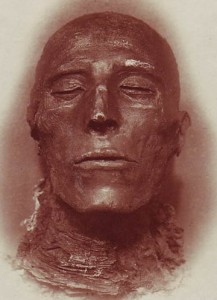Hiding Mummies
by Heather Pringle
July 4, 2008
 A few days ago, I received a fascinating email from a British researcher concerning a worrying decision that the Manchester Museum recently made. This rather dour Victorian-looking museum holds a large and very prestigious collection of Egyptian mummies—more than a dozen human mummies and 31 animal mummies, many of which were excavated in the nineteenth century by the likes of Sir Flinders Petrie. Over the past 30 years, the Manchester mummies have inspired important research projects and a new scientific specialization: biomedical research in Egyptology.
A few days ago, I received a fascinating email from a British researcher concerning a worrying decision that the Manchester Museum recently made. This rather dour Victorian-looking museum holds a large and very prestigious collection of Egyptian mummies—more than a dozen human mummies and 31 animal mummies, many of which were excavated in the nineteenth century by the likes of Sir Flinders Petrie. Over the past 30 years, the Manchester mummies have inspired important research projects and a new scientific specialization: biomedical research in Egyptology.
In May, the powers that be at the museum decided to cover up the mummies on display. The British public, observed museum director Nick Merriman in a BBC interview, now question the ethics of displaying the dead, particularly after the controversial exhibit of human anatomical specimens, Body Worlds 4, opened in Britain. So the Manchester Museum dutifully responded by reshrouding its mummies.
But was the museum really acting on the public’s behalf? I have toured that gallery, and can attest that it presents the mummies with reverence. Moreover, I could see that children and adults alike loved it. Indeed, Rosalie David, a former Keeper of Egyptology at the museum, once told me that “the first thing that people ask us when they come in the doors is ‘Where are the mummies and where are the dinosaurs?’ â€
So I wasn’t surprised to learn that the decision has infuriated the museum’s greatest fans, stirring up an angry beehive’s worth of comments from more than 150 people on its website. It seems that the museum staff badly misjudged public sentiment, pandering instead to the oppressive climate of political correctness in some academic circles.
I sincerely hope that this fiery public reaction will dissuade other museums from following suit. The Egyptians, after all, are not clamoring to remove mummies from public view: indeed they display the bodies of ancient pharaohs in the Egyptian Museum in Cairo. And I personally feel that the Egyptian mummy exhibits draw children away from the artificial worlds of video games and Second Life and into the galleries of the world’s major museums. The small number of mummies on display worldwide profoundly stir the imagination of the young, and, for many, they inspire a lifelong interest in archaeology and Egyptology.
That’s not something to toss away—without a big fight.
Comments posted here do not represent the views or policies of the Archaeological Institute of America.






 Heather Pringle is a freelance science journalist who has been writing about archaeology for more than 20 years. She is the author of Master Plan: Himmler's Scholars and the Holocaust and The Mummy Congress: Science, Obsession, and the Everlasting Dead. For more about Heather, see our
Heather Pringle is a freelance science journalist who has been writing about archaeology for more than 20 years. She is the author of Master Plan: Himmler's Scholars and the Holocaust and The Mummy Congress: Science, Obsession, and the Everlasting Dead. For more about Heather, see our 



